

SuDS-related links
Keeping ahead
with SuDS
Attend SuDS training to keep ahead of the competition and to deliver innovative solutions in line with recognised good practice.
home > CIRIA SuDS publications > publications
.gif) |
Planning for SuDS - making it happen is primarily intended for use by those people involved in the planning and development process requiring independent and digestible information on the delivery of SuDS. The guidance provides an easy to use reference for those not overly familiar with SuDS, the planning and development process or a mixture of both, and should be viewed within the wider context of surface water management. This guide will help the planning, design and delivery of attractive and high quality SuDS schemes - efficiently delivered SuDS will unlock other sustainability benefits. Visit CIRIA's website to order a copy FREE: Follow this link |
|---|
This publication provides guidance on how to achieve improved sustainable water cycle management in new developments. It outlines the policy context and the processes involved in sustainable water cycle management focusing on why it is required and what approaches are needed for its successful planning and delivery. The research for the guidance was conducted by the WaND (water cycle management for new developments) research project whose aim was to support the delivery of a more integrated and sustainable approach to water management for new developments by the provision of tools and guidelines for project design, implementation and management. This guidance is based on the information collated in this multi-disciplinary research and presents the results for practitioners involved in water cycle management in new developments. Visit CIRIA's website to order a copy |
|
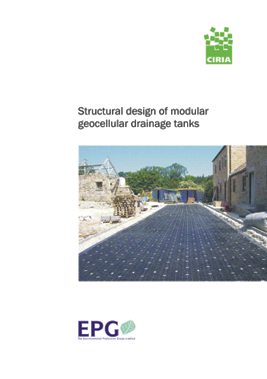 |
Stormwater attenuation tanks constructed using modular plastic geocellular units are commonly used as part of sustainable drainage and rainwater reuse systems. This guidance discusses the different types of unit that are available and the differences in their structural performance. It provides information on many full scale trials that have been carried out on various systems and gives a detailed assessment of the factors that affect their structural performance. It also includes guidance on appropriate testing and structural design together with a discussion of the practical issues that should be considered during construction. Visit CIRIA's website to order a copy |
|---|
Green roofs and walls are widely used in many countries to provide a range of benefits for the built environment. Numerous studies have been carried out to monitor and assess the effectiveness of green roofs and green walls in the areas of biodiversity, stormwater management and climate change mitigation and adaptation. This guidance results from a detailed assessment of published information on green roof and walls and provides guidance on their design, construction and operation. The guidance also describes how ‘quick wins’ for biodiversity can be achieved in the built environment by incorporating nesting and roosting boxes for birds, bats and other animals. Visit CIRIA's website to order a copy |
|
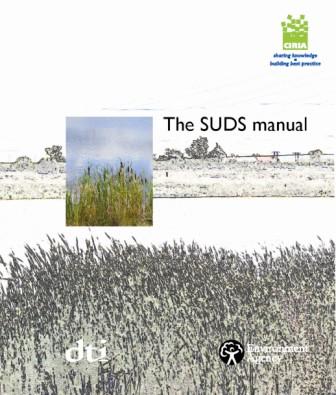 |
This guidance provides best practice guidance on the planning, design, construction, operation and maintenance of Sustainable Drainage Systems (SUDS) to facilitate their effective implementation within developments. The guidance supersedes previous general guidance on SUDS and addresses landscaping, biodiversity issues, public perception and community integration as well as water quality treatment and sustainable flood risk management. A separate site handbook (C698) Site handbook for the construction of SUDS on the construction of SUDS has also been produced. FREE: Follow this link Visit CIRIA's website to order a copy |
|---|
This handbook provides guidance on the construction of Sustainable Drainage Systems (SUDS) to facilitate their effective implementation within developments. The handbook is aimed at site engineers and SUDS practitioners. The handbook can also be used in conjuction with CIRIA publication C697 The SUDS Manual that provides comprehensive guidance on the planning, design, construction and operation of SUDS. FREE: Follow this link Visit CIRIA's website to order a copy |
|
 |
CIRIA has produced free guidance Sustainable water management in schools (W012) for use by the UK Department for Education and Skills, Local Education Authorities, head teachers and school governors - as wedesigners and contractors involved in building and refurbishing schools. The publication focuses on the principles and best practice of incorporating sustainable water management into school design and sets out the business case for doing so. The online document aims to be a first point of reference for those involved in the building and refurbishment of schools. FREE: Follow this link |
This guidance aims to provide best practice advice for the design and management of urban sewerage and drainage systems to reduce the impacts that arise when flows occur that exceed their capacity. It includes information on the effective design of both underground systems and overland flood conveyance. It also provides advice on risk assessment procedures and planning to reduce the impacts that extreme events may have on people and property within the surrounding area. It provides guidance so that systems can be designed to safely and sustainably accommodate periods when the design capacity of drainage systems are exceeded during extreme events. FREE: Follow this link Visit CIRIA's website to order a copy |
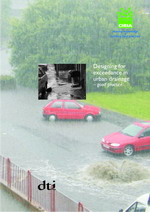 |
|---|
|
|
The Interim Code of Practice for Sustainable Drainage Systems (SUDS) aims to facilitate the implementation of sustainable drainage in developments in England and Wales by providing model maintenance agreements and advice on their use. It provides a set of agreements between those public organisations with statutory or regulatory responsibilities relating to SUDS. The planning model agreements used in conjunction with the Interim Code of Practice are those provided by CIRIA publication C625 Model agreements for SUDS and have been based on a detailed legislation review and consultation undertaken during CIRIA Project RP664 Model agreements for sustainable water management systems. FREE: Follow this link |
This guide provides basic advice on the use and development of model operation and maintenance agreements for sustainable drainage systems together with simple guidance on their incorporation into developments. The book identifies maintenance considerations and provides an outline of ways in which the long-term responsibilities for the maintenance of the SUDS can be allocated. Provided with the book are three model agreement booklets and a CD containing electronic files of the model agreements. Visit CIRIA's website to order a copy |
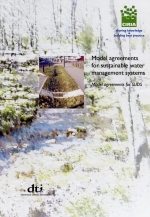 |
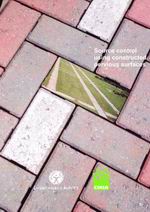 |
This book discusses the critical issues that should be considered when designing and constructing pervious pavements that are to be used as a technique for stormwater source control. It details the types of surfaces available and provides examples of developments that have used these techniques. It explores the issues you need to consider relating to the hydraulic, structural and water quality performance of pervious surfaces. Finally, the book provides a design framework, which includes detailed recommendations for methods where necessary. To assist the reader in finding the relevant sections when using this design framework, key sections of text have been highlighted throughout the book. This book is intended for a wide readership including landscape architects, consulting engineers, highway authorities, environmental regulators, planners, contractors and other organisations involved in the provision or maintenance of surface water drainage to new and existing developments Visit CIRIA's website to order a copy |
A selection of other relevant publications are also available from CIRIA:
Drainage of development sites - a guide (X108)
The guide is intended to assist all those involved with foul and
surface water drainage of development sites. It is aimed specifically at developments
in the UK based on national requirements and international best practice.
Free to download here
Visit CIRIA's website to order
a copy
Infiltration drainage – manual of good practice
(R156)
If you are involved in the planning, funding, design, construction or maintenance
of infiltration systems and wish to use infiltration drainage as a method
to control and dispose of stormwater, this manual is essential reading.
Visit CIRIA's website to order
a copy
Review of the design and management of constructed
wetlands (R180)
This state-of-the-art review details the benefits and limitations of constructed
wetlands to treat domestic, agricultural and industrial wastewater, and urban
and highway runoff.
Visit CIRIA's website to order
a copy
Control of pollution from highway drainage discharge
(R142)
This book reviews the pollutants that are likely to be present in highway
drainage discharges, and assesses the impact that these can have on the receiving
water.
Visit CIRIA's website to order
a copy
Design of flood storage reservoirs (Book 14)
This book is intended primarily to assist the practising engineer with the
detailed design of flood storage reservoirs for flood control in partly urbanised
catchment areas.
Visit CIRIA's website to order
a copy